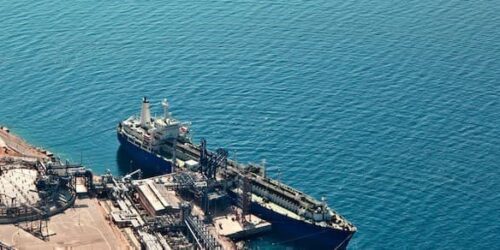Qatar’s recent announcement that it would build the world’s largest LNG production facility did not prompt any applause from other LNG producers. Now, the tiny Gulf nation is also cutting its prices and expanding into the spot market to retain its number-one position in LNG exports. This could result in the death of some planned U.S. LNG projects.
U.S. liquefied natural gas quickly became a threat for the world’s top exporter. While Qatar is still the cheapest LNG producer, the abundance of shale gas made it cheap and competitive in some markets, which in turn led to a flurry of LNG projects as the U.S. staked its claim on the international market.
The country quickly found a place among the world’s largest exporters, thanks not least to the fact that U.S. LNG producers index their gas to Henry Hub benchmarks rather than crude oil. The quickly growing spot market for LNG was also favorable for these producers. No wonder so many more projects followed the first wave of LNG capacity. Yet not all of them made it, and more are under threat of becoming commercially unviable.
Some already have: the list of LNG projects awaiting a final investment decision has shrunk in the last year and while part of the reason was the pandemic, the other part was that the economics for most of these projects had changed. According to Wood Mackenzie, this year, no new LNG project in the United States will reach a final investment decision, either. The reason: it’s tough to find long-term buyers.
“Generally, we’ve seen a slowdown in the pace of sales contract activity,” said Wood Mackenzie’s principal analyst for North American LNG, Alex Munton, as quoted by Natural Gas Intelligence. “Pre-FID projects will continue to struggle to secure buyers, given the huge wave of LNG currently under construction globally. For that reason, we see a limited window to project FIDs in the U.S. for the next couple of years.”
Related Video: Michigan – Enbridge Pipeline War Hits Climax
Competition is certainly tough in the LNG space, and with Qatar firmly on the path to securing its number-one spot over the long term, it will get even tougher. There are many LNG producers around the world, but they are all higher-cost than Qatar.
“Nobody can compete with Qatari costs,” according to Jonathan Stern, a senior research fellow at the Oxford Institute of Energy Studies, as quoted by Bloomberg in a recent report. “They can do whatever they like and everybody will have to respond the way they can. And, especially when the market is in surplus and prices are low, that will impact the competition’s profits.”
One might reasonably ask why bother with LNG then if nobody can compete with Qatar on prices. The reason to bother is that large buyers like to have the comfort of supply diversity, and this makes them willing to pay a little more—or a lot more in some cases—to avoid being completely dependent on a single, albeit lowest-cost, producer.
Yet cost is important, and for some import markets, so are emissions. Europe is a big consumer of gas, but it is also a big proponent of renewable energy and low emissions. At the moment, renewable energy is winning the fight when it comes to new electricity generating capacity.
“Most European utilities don’t want to touch gas-related projects with a barge pole as companies seek to improve their ESG metrics, improve valuation and avoid stranded asset risks,” said Bloomberg Intelligence analyst Elchin Mammadov earlier this month.
What’s worse, per a Bloomberg report from earlier this month, European utilities are trying to come up with alternative uses for liquefied natural gas because there is not enough demand for it for electricity generation.
So, Asia remains the key focus for U.S. LNG producers. The problem here is that it is also the key focus for every other LNG producer in the world, from Qatar to Mozambique and Australia.
“With the Qataris adding more capacity at a very cheap cost, it does not make financial sense for U.S. companies to be building greenfield projects,” Reuters quoted Matt Smith, commodity research director at Clipper Data as saying this week. Smith said that in the current supply environment it made a lot more sense to add trains to already existing facilities.
There are currently three or four LNG projects in the U.S. that plan to have a final investment decision by the end of the year. Tellurian appears confident it would be able to make a final investment decision on its Driftwood project this year. Sempra Energy, on the other hand, has pushed the FID for its Port Arthur LNG project to next year. This is the latest in a series of delays in the final investment decision on the project.
Finding long-term buyers to make the necessary commitments for a whole new LNG plant was hard even before the pandemic. Now, with Qatar on the warpath, Wood Mackenzie’s forecast may turn out accurate, and all of these FIDs planned for this year might get pushed forward to 2022 or later. Worse, the projects might get shelved as Europe snubs hydrocarbon LNG and Asian buyers shun long-term contracts that secure the money for new LNG facilities that cost billions to build.






